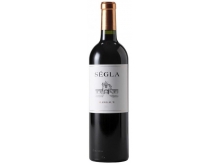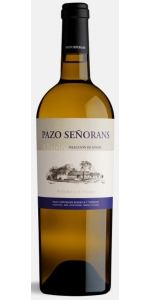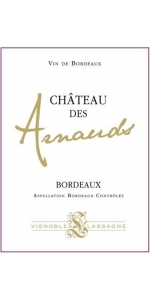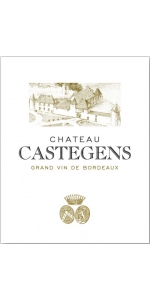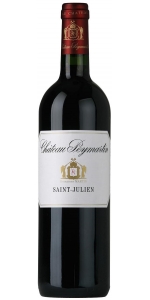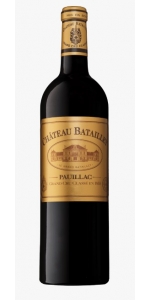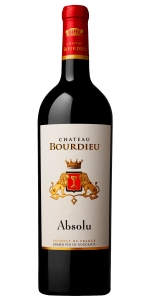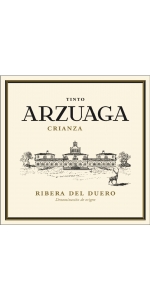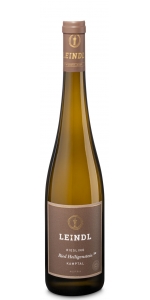Chateau Rauzan-Segla 2014
| Country: | France |
| Region: | Bordeaux |
| Winery: | Segla |
| Grape Type: | Cabernet Sauvignon |
| Organic: | Yes |
| Vintage: | 2014 |
| Bottle Size: | 750 ml |
Pazo de Senorans Seleccion de Anada Albarino is made from 100 percent Albarino.
Straw yellow with greenish tints, vivid and brilliant. High intensity and very expressive. Profusion of aromas with traces of mineral. Great volume and ample body leaving a lasting impression from beginning to end.
Reviews:
I think the 2014 Albariño Selección de Añada could be the finest vintage of this characterful long-aging Albariño, from a year with a more moderate 13% alcohol and very high acidity (and low pH) that make the wine fresher and more vibrant. It is developing very slowly and showing quite young after it spent over 30 months with lees in 1,500- and 3,000-liter stainless steel tanks. It has a pale color and an elegant nose with notes of freshly cut grass, white flowers and wet granite. The palate is vibrant with effervescent acidity, and it has a long, dry and tasty finish with an austere sensation, far away from the tropical notes of some past vintages. This is superb and should continue developing nicely in bottle. Bravo! It wasn't bottled until April 2023, and 14,000 bottles were produced.
-Wine Advocate 96 Points
Tech:
Chateau Arnauds des Bordeaux Rouge is made from 100% Merlot.
The wine shows a deep red purple color and intense aromas of black fruits (blackcurrant, black cherry) with hints of liquorice. Very fruity and well-balanced. It is powerful and well structured in the mouth with round and silky tannins, ripe flavors of black fruits. Strong and a slightly spicy finish.
Grapes are coming from 30 year old vines planted on gravelly soils.
The land benefits from sun exposure, warmth and humidity that are strong assets for the vine culture.
The wine pairs well with game meat and beef on the grill.
Chateau Castegens Cotes de Bordeaux Castillon is made from 80% Merlot, 18% Cabernet Franc and 2% Cabernet Sauvignon.
The wine boasts an intense, deep and lively red color. The nose offers black fruit, blackberry, cigar box, licorice, some delicate and integrated oak flavors as well. The mouth is full of fruit flavors, spice and fine toasty flavors. The structure is rich, but the tannins are well integrated already. The finish is long and a slight mintiness give the wine a great length and some purity.
Pairs great with meat and vegetables on the grill.
Chateau Peymartin Saint-Julien is made from 65% Cabernet Sauvignon, 25% Merlot, 5% Petit Verdot.
Peymartin is the second wine of Gloria, produced using the youngest vines (average 40 years-old) on the estate.
After a manual harvest, the grapes are vinified in thermo regulated stainless steel vats with malolactic in barrel. Peymartin spends approximately one year in cask followed by additional aging at the estate in bottel prior to release. The ensuing style of wine is typically a lighter and more elegant St. Julien, known for its early drinkability and charming character.
Tasting Notes:
Deep ruby-garnet in appearance, Peymartin is classic left-bank Bordeaux. Aromas of dried tobaco, cedar, blackcurrant, and pungent cooking spices greet the nose. The palate is extremely elegant with ripe, yet structured tannins balanced by firm acidity, black fruits, savory earth, and hints of toasted vanilla. A balanced and persistent finish underlines the wine's quality as well as its ability to hold up in bottle.
Chateau Batailley Grand Cru is made from 78% Cabernet Sauvignon, 19% Merlot, 2% Petit Verdot & 1% Cabernet Franc.
Château Batailley is a winery in the Pauillac appellation of the Bordeaux region of France. The wine produced at the estate was classified as one of eighteen Cinquièmes Crus (Fifth Growths) in the Bordeaux Wine Official Classification of 1855.
Garnet-purple colour. Rich and expressive nose, fruity with notes of spices, smoke and vanilla. On the palate, this wine is supple, round, well balanced, with good acidity, a nice fruitiness and nice notes of leather and cedar. Long elegant finish.
Review:
The 2010 Batailley repeated its magnificent showing when poured at the chateau. It has a detailed bouquet of blackberry and cedar, quite backward and seemingly having advanced lite since | tasted in in April 2016. The palate remains full of tension and brimming with energy, delivering classic cedar and tobacco notes toward the persistent finish. Batailley can produce wines that live many decades, and this is clearly one of them. Tasted at the property. Drink 2020-2050
- Neal Martin Vinous 95 Points
Chateau Bourdieu Absolu Blaye Cotes de Bordeaux is made from 79% merlot, 17% Cabernet Sauvignon, 4% Malbec.
When Luc Schweitzer was joined by his two sons Richard and Ludovic at the estate, he wanted to embrace this new chapter in the family history and launched in 2016 a special cuvée from Château Bourdieu called "Absolu". This top-of-the-range cuvée is the best of what their terroir has to offer. The 35 year-old facing south vines benefit from a meticulous care: regular maintenance of the soil, yield control, manual leaf stripping, sorting of the berries - all practices that ensure the quality of this great Bordeaux wine.
A deep garnet color with magnificent purple highlights. The nose is intense and full, revealing notes of ripe black fruits and subtle hints of vanilla and roasted coffee. Great structure with finesse and tannic density that brings depth and length to the mouth. The aromatic purity of the perfectly ripened grape varieties is magnified by the complex and subtle oak flavors.
Pair: Rib of grilled beef and tournedos Rossini - butter pan-fried beef filet served on a crouton, and topped with a hot slice of fresh foie gras.
Review:
"A rich, opulent wine, this is full of dark tannins and powerful fruit. It's a big wine, with licorice and dense wood flavors that give a smoky character and reflect some serious extraction. The wine needs to smooth out to showcase its concentrated richness. Drink from 2024. - Roger VOSS"
- Wine Enthusiast (May 2021), 91 pts
Chateau Rauzan-Segla is made from 54% Cabernet Sauvignon, 41% Merlot, 4% Petit Verdot, 1% Cabernet Franc.
Ségla is the second wine of the prestigious Château Rauzan Ségla and a Craft + Estate exclusive. The history of Château Rauzan-Ségla dates back to 1661 when Pierre de Rauzan acquired the estate. Rauzan-Ségla grew in reputation in a remarkable way and produced some of the most highly rated wines in Bordeaux. They delighted many well-known dignitaries, most notably Thomas Jefferson who came across this wine during his visit to Bordeaux in 1787, subsequently placing an order for several cases in 1790. Some decades later, the historic 1855 Bordeaux Classification ranked Château Rauzan-Ségla as a 2nd Growth. Today, the property is owned by the Wertheimer family of the fashion house Chanel and managed by Nicolas Audebert.
About half of the 126 acres (51 hectares) of vineyard are around the château, but there are additional parcels near Château Margaux and Brane-Cantenac. The vines are comprised of 54% Cabernet Sauvignon, 40% Merlot, 5% Petit Verdot and 1% Cabernet Franc, with an average vine age of 30 years and a vine density of 2,670 to 4,050 plants per acre (6,600 to 10,000 vines/ha). Soils at Rauzan-Ségla are composed of deep, fine gravel, which makes for natural irrigation.
More accessible than the first wine, the aim for Ségla is to produce a wine of extremely good quality and value reflecting all the elements of Margaux and giving a true insight to the quality of the Grand Vin. The estate puts the same amount of effort and care into the production of Ségla as it does the first wine, making it a true and authentic introduction to the château.
Review
This is a full-bodied wine, from one of the leading estates in Margaux. It is ripe with juicy blackberry and black-currant fruits. This fruit contrasts with the dark tannins and powerful structure. It is going to develop slowly and impressively to be ready to drink from 2025.
-Wine Enthusiast 95 Points
Ségla is the second wine of the prestigious Château Rauzan Ségla and a Craft + Estate exclusive. The history of Château Rauzan-Ségla dates back to 1661 when Pierre de Rauzan acquired the estate. Rauzan-Ségla grew in reputation in a remarkable way and produced some of the most highly rated wines in Bordeaux. They delighted many well-known dignitaries, most notably Thomas Jefferson who came across this wine during his visit to Bordeaux in 1787, subsequently placing an order for several cases in 1790. Some decades later, the historic 1855 Bordeaux Classification ranked Château Rauzan-Ségla as a 2nd Growth. Today, the property is owned by the Wertheimer family of the fashion house Chanel and managed by Nicolas Audebert.
About half of the 126 acres (51 hectares) of vineyard are around the château, but there are additional parcels near Château Margaux and Brane-Cantenac. The vines are comprised of 54% Cabernet Sauvignon, 40% Merlot, 5% Petit Verdot and 1% Cabernet Franc, with an average vine age of 30 years and a vine density of 2,670 to 4,050 plants per acre (6,600 to 10,000 vines/ha). Soils at Rauzan-Ségla are composed of deep, fine gravel, which makes for natural irrigation.
More accessible than the first wine, the aim for Ségla is to produce a wine of extremely good quality and value reflecting all the elements of Margaux and giving a true insight to the quality of the Grand Vin. The estate puts the same amount of effort and care into the production of Ségla as it does the first wine, making it a true and authentic introduction to the château.
Arzuaga Ribera del Duero Crianza 95% Tempranillo and 5% Cabernet Sauvignon.
Dark cherry color with purple highlights. Powerful nose and high aromatic diversity of ripe red and black fruits, spicy and balsamic notes, and a roasted finish. Soft and mellow in the mouth with a great fruitiness and length.
Review:
This is a big wine with alluring aromas of cedary oak and black fruit. Ripe palate of black berries, some dark chocolate and integrated, polished oak. Long spicy finish. Classy Ribera. -Decanter 95 Points
Leindl Riesling Zobinger Heiligenstein Kamptal is made from 100 percent Riesling.
Medium yellow green. Fine nuances of ripe apricot, a hint of yellow apple, delicate herbs and spices, mineral Touch, hints of candied orange zest. Juicy, elegant, fine stone fruit, touch of finesse acidity, salty minerality in the finish, remains long, already well to drink.
Cold Fermentation.
Aged on the lees for 12 months in Stainless Steel tank. No Oak.
No ML
Review:
"Aged on the lees for 12 months in stainless steel, this wine saw no oak. Its original name – Hellenstein -- referred to hell stone, as the vineyards are on a mountain where the “sun burns like hell.” It was later renamed Heiligenstein, which translates as holy rock, and is a geological island of desert sandstone, with volcanic matter. Its earthy slate character lends out scents and flavors of honeyed apricot, salty pears, and stone fruit pith."
-The Tasting Panel (May/June 2022), 94 pts
- back
Corne Loup Cotes du Rhone Blanc is made from 50% Grenache Blanc, 20% Clairette, 15% Roussanne and 15% Viognier.
The wine has a pale straw color with brilliant reflection. In the nose, it displays great aromatics, mainly citrus fruit. The palate is well balanced, with a lot of finesse and persistence.
Delicious when paired with seafood (seashell and fish). It is also great by itself as an aperitif.
Gentilhommes Macon-Peronne is made from 100 percent Chardonnay.
A gentilhomme is a gentleman characterized by his delicacy, thoughtfulness, and courtesy. "Les Gentilhommes" was created by brothers Richard and Stephane Martin as brand embodying the gentleman's character combined with Burgundian know-how.
From the work in the vineyard to the vinification in barrel, they are inspired to share these noble values. Quality, authenticity and long family tradition are the foundation of these wines.
This single-vineyard Chardonnay is produced in the village of Péronne, in the heart of the Maconnais region in Burgundy, from 40 year-old vines planted on the limestone based soils of the Mount Epin.
A beautiful golden color with green reflections, delicate toasty notes and attractive aromas of citrus and ripe summer fruits combine with floral and honey nuances that are typical of the old vines.
Fresh, ample and full-bodied on the palate, the wine is perfect by itself as an aperitif and delicious during the meal.

